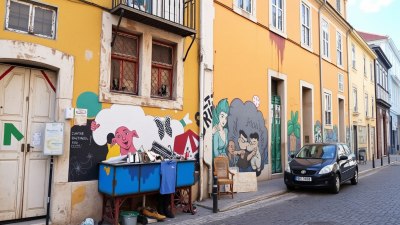Golden Rot and Other Surprises in Lisbon’s Corners
Discover Lisbon's hidden gems and the enchanting Golden Rot phenomenon in this fascinating exploration.

Image created with Flux Schnell
Lisbon, the capital of Portugal, is renowned for its rich history, vibrant culture, and stunning architecture. However, in the bustling streets and vibrant neighborhoods, there exist hidden corners and surprising marvels that can easily be overlooked by the untrained eye. Among these is the concept of 'Golden Rot,' a term that encapsulates the beauty of decay and transformation within this ancient city. In this article, we delve into the enigmatic relationship between the past and present in Lisbon, exploring both the physical and cultural landscapes that define its unique charm.
Understanding Golden Rot
'Golden Rot' refers to the aesthetic appreciation of decay, particularly as observed in Lisbon's vibrant street art, dilapidated buildings, and weathered facades. This phenomenon often evokes a sense of nostalgia and beauty in the memories that linger, despite the wear and tear of time. In places like Bairro Alto and Alfama, abandoned structures and peeling paint coexist harmoniously with colorful murals and lively street scenes. This juxtaposition reflects Lisbon's resilience, as it continually reinvents itself while honoring its past.
The Allure of Alfama
Alfama, one of Lisbon's oldest neighborhoods, is a labyrinth of narrow streets and alleys that seem to tell stories from centuries ago. The district's name is derived from the Arabic word 'al-hamma,' meaning 'hot springs.' Here, layers of history are visible in the tile-covered walls, intricate wrought-iron balconies, and the iconic Fado houses where sorrowful melodies echo into the night. Strolling through Alfama, visitors are often greeted by the delightful aromas of grilled sardines and fresh pastries from local bakeries. It’s a feast for the senses, where every corner reveals another surprise.
Street Art Renaissance
Lisbon is not only a city of history but also a canvas for contemporary artists. The streets have transformed into an open-air gallery, showcasing remarkable street art that covers entire buildings. This growth in street art has combined the old with the new, as many murals incorporate themes of Lisbon's legacy, cultural figures, and social movements. Artists like Vhils, who carves intricate portraits from the walls, and Bordalo II, known for his environmentally conscious works made from scrap materials, highlight the layers of Lisbon's urban narrative. Their work, alongside that of many others, encourages a dialogue between the past and present as they address current social issues through their art.
Exploring the Time-Worn Tiles
One cannot speak about Lisbon without mentioning the iconic azulejos, the decorative ceramic tiles that adorn buildings throughout the city. These tiles date back to the 15th century and come in various patterns and colors, often depicting historical events, floral motifs, and daily life scenes. As tiles age, they can develop a beautiful patina, contributing to the concept of 'Golden Rot.' Guided tours often focus on the history and importance of azulejos, allowing visitors to understand their cultural significance. Hidden corners may reveal entire walls of chipped and cracked tiles that tell stories of Lisbon’s ups and downs over the centuries.
The Gastronomic Revival
Lisbon's food scene is another area where the old meets the new. Traditional Portuguese cuisine, known for its hearty flavors and regional diversity, is experiencing a renaissance in recent years. Restaurants have emerged that honor classic dishes while infusing them with modern twists, reflecting a broader trend of culinary experimentation. The emergence of 'tascas'—small, traditional restaurants—alongside contemporary eateries showcases Lisbon's ability to bridge generational divides with food. Visitors can enjoy a delicious bacalhau à brás, a dish made from salted cod, or explore innovative takes on gourmet pastéis de nata, the famous custard tart.
The Tejo River: A Living Canvas
The Tejo River, which flows through Lisbon, plays a pivotal role in the city's life. The waterfront showcases the dynamic interplay of nature and urbanism, with old ships and modern vessels coexisting along the riverbanks. One of the most surprising features here is the multitude of artistic installations that pop up along the shores, some of which are impermanent and highlight issues of environmental conservation. This river has also been a source of inspiration for numerous artists and musicians, further cementing its status as a living canvas within the city.
Christ the King Statue: Overlooking Change
On the southern bank of the Tejo, the towering Christ the King statue offers breathtaking panoramic views of Lisbon. Inspired by the Christ the Redeemer statue in Brazil, this monument serves as a symbol of faith and hope for the people of Lisbon. From this vantage point, visitors can appreciate the city's transformation from a once-ravaged capital to a thriving metropolis. The majestic view underlines the essence of 'Golden Rot'—evidence of both the city's scars and its rejuvenation, painted against the backdrop of vibrant neighborhoods and historic landmarks.
Uncovering Belém’s Treasures
Belém, a district steeped in maritime history, is another essential stop for those uncovering Lisbon’s surprises. The monumental Jerónimos Monastery and the iconic Tower of Belém are UNESCO World Heritage sites that echo the Age of Discoveries. Within the area, the famous Pastéis de Belém pastry shop tempts visitors with its flaky custard tarts, a testament to Lisbon's culinary heritage. Yet, amidst these well-known landmarks lies an array of hidden gardens, charming cafés, and local artisans that add to the charm of Belém, offering abundant surprises for those willing to explore beyond the tourist paths.
Lisbon at Night: Another World Awakens
As the sun sets, Lisbon transforms. The lively nightlife offers a different perspective on the city, as bars and clubs come alive with motion and sound. The streets of Bairro Alto, with their traditional bars and lively atmosphere, often host impromptu parties. Here, visitors encounter an eclectic mix of music, food, and vibrant personalities. The colorful lights reflect off the cobblestones, echoing the transformative narrative of 'Golden Rot' where the vibrancy of life reigns over mere decay. As nightlife pulses, one can feel the energy of generations intertwining, each contributing to the culture of Lisbon.
Finding Hidden Gardens and Green Spaces
Behind the bustling streets of Lisbon, hidden gardens offer serene retreats where one can escape the urban chaos. The Jardim da Estrela and the Estufa Fria are just two examples of these tranquil spots replete with flora and the gentle sounds of nature. These gardens not only serve as places of beauty but also as reminders of life's fleeting existence. The interplay of manicured landscapes and wild growth reflects the essence of decay—beauty thrives alongside imperfection, celebrating a life that continues to evolve.
Lisbon in Constant Transition
Lisbon is a city of contrasts where the echoes of the past resonate within the fabric of modern life. The concept of 'Golden Rot' beautifully embodies this juxtaposition, offering a lens through which one can appreciate both decay and transformation. From the intriguing streets of Alfama to the colorful murals that adorn crumbling walls, every hidden corner of Lisbon whispers stories of endurance and renewal. As visitors explore, they uncover not only the triumphs of history but also the vibrant culture that pulsates through the heart of this enchanting city. Embark on this journey to discover Lisbon’s surprises and see how, through the beauty of 'Golden Rot,' you can find wonder in even the most unlikely places.











